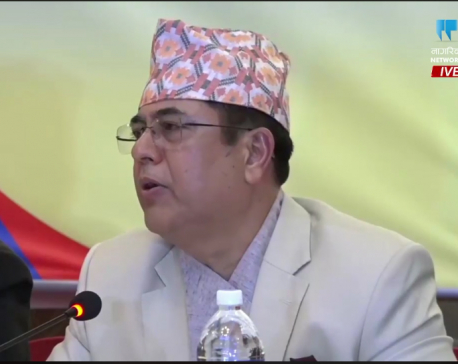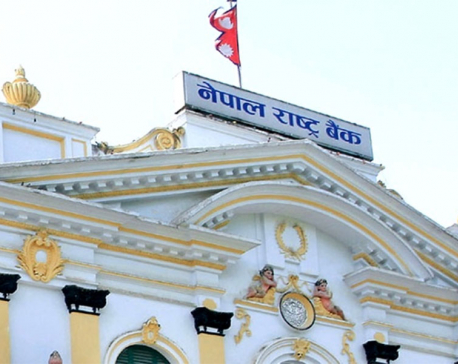
OR
Nepal Rastra Bank turns flexible on home loans for first-time home buyers
Published On: March 4, 2020 09:45 AM NPT By: Republica | @RepublicaNepal

KATHMANDU, Mar 4: The Nepal Rastra Bank (NRB) has softened its lending limit for first-time homebuyers giving respite to the manufacturers of construction materials that have been running in under capacity.
Through unveiling the revised Monetary Policy for 2019/20 on Monday, the central bank has raised the upper limit of debt service to gross income ratio (DTI), for the first time purchaser of residential home at 60% from the previous 50%. It means that the individual having income of Rs 100,000 per month, can receive home loan to pay the monthly installment of up to Rs 60,000.
The central bank, through the Monetary Policy 2019/20, had talked to enforce limit for the DTI for the installment-based non-business loans such as personal loans, home loans and hire purchase loans, among others. Last November, the limit was introduced at 50% to the first-time home buyers.
The central bank has kept unchanged the loan to value (LTV) ratio – the maximum amount of loans that a bank can float out of the total valuation of the collateral – to 70% for such first-time home buyers. This means that the bank can provide loan amount up to 70% of the total valuation of the home to the borrower.
Gunakar Bhatta, spokesperson of the NRB, said the central bank revised the policy targeting to benefit first time home buyers. “In addition, the changed policy is expected to give pace to the businesses of construction materials targeting to help speed up the economic growth,” said Bhatta. According to the Economic Activities Study Report 2018/19, published by NRB few months ago, most of the manufacturing companies of the construction materials have been running in under capacity based on the slow demand in the sector.
Besides, the NRB has redefined the LTV ratio limit for the licensed realty business.
According to the revised policy, the limit for the home loan for the housing business in metropolitan, sub-metropolitan and municipalities adjoining to Kathmandu Metropolitan is raised to 50% from 40%. Similarly, the limit of such loan in locations other than aforementioned areas has been raised to 60% from 50%. According to Bhatta, limit for such residential home loans was capped at 50% inside the Kathmandu Valley and 60% outside the valley.
Similarly, the central bank has also turned flexible when it comes for the need of the tax clearance certificates for the first-time-home buyers and the loan of Rs 5 million-Rs 20 million taken by the businesses related to agriculture, tourism and small and medium enterprises. In such type of loans, the borrowers are now issued the credit by just submitting the receipt of the tax payment. “Earlier, these borrowers needed to produce the tax clearance certificates to get the bank loans, which usually took longer time for the entire process,” Bhatta said.
The revised monetary policy however has turned stern on the profit seeking microfinance institutions. From now onwards, those microfinance that intend to provide more than 20% bonus to the shareholders, will have to keep 25% of the excess amount each in funds targeted for customers' protection and corporate social responsibility. Previously, the microfinance institutions were mandated to invest only in the customers' protection fund.
Bhatta said that, through the policy, the central bank has targeted the microfinance institutions to invest in public goods and financial literacy programs.
Through the Monetary Policy 2019/20, the NRB has asked the microfinance institutions to invest at least one third of their lending in agriculture. According to the NRB, these institutions injected 41% of their loan portfolio in agriculture as of first six months of the current fiscal year.
The revised monetary policy has maintained the cash reserve ratio unchanged at 4% and the bank rate at 6%. Likewise, the statutory liquidity ratios for commercial bank, development bank and finance companies have been kept at 10%, 8% and 7% respectively. Through the policy document, the central bank has reiterated its commitment to effectively implement the interest rate corridor to maintain interest rate stability.
You May Like This

Monetary policy aims to lower interest rates, ease 'credit crunch'
KATHMANDU, July 25: Nepal Rastra Bank (NRB) has introduced its monetary policy for the new fiscal year 2019/20, focusing on making... Read More...

PAN number mandatory for loan above Rs 5m
KATHMANDU, July 24: Nepal Rastra Bank has made mandatory provision to possess PAN number for those seeking loans above Rs... Read More...

NRB increases refinance fund size to Rs 50 billion
KATHMANDU, Feb 20: Nepal Rastra Bank (NRB) has released the mid-term review report of the monetary policy for the current Fiscal... Read More...










Just In
- Heavy rainfall likely in Bagmati and Sudurpaschim provinces
- Bangladesh protest leaders taken from hospital by police
- Challenges Confronting the New Coalition
- NRB introduces cautiously flexible measures to address ongoing slowdown in various economic sectors
- Forced Covid-19 cremations: is it too late for redemption?
- NRB to provide collateral-free loans to foreign employment seekers
- NEB to publish Grade 12 results next week
- Body handover begins; Relatives remain dissatisfied with insurance, compensation amount







Leave A Comment